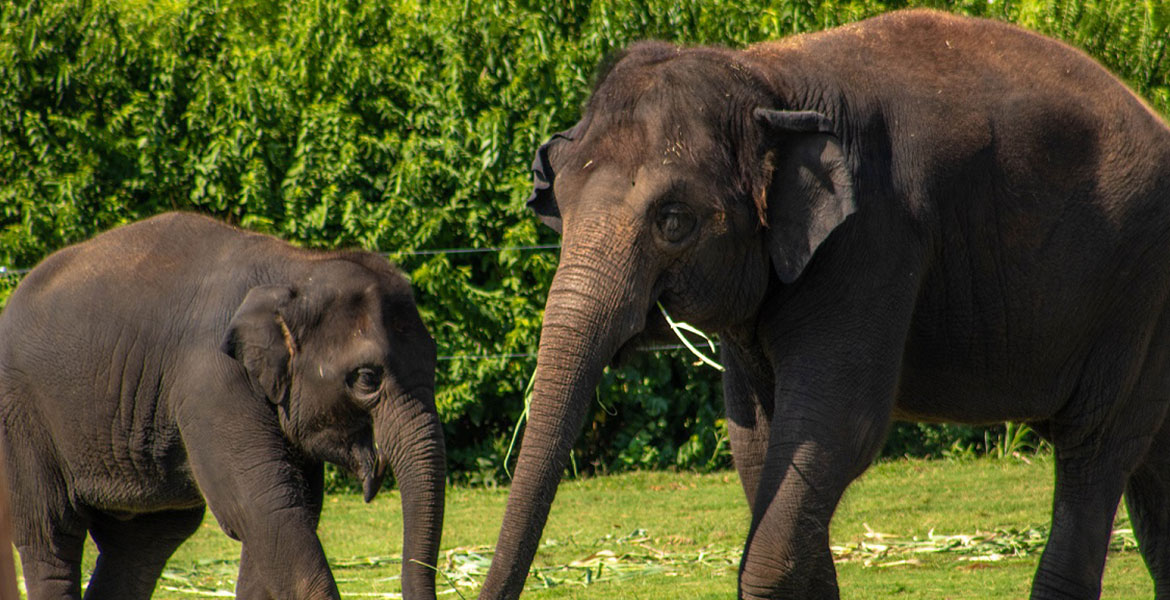
Partnering to Advance Elephant Healthcare
Wednesday, August 22, 2018
Elephant endotheliotropic herpesvirus (EEHV) is the leading cause of mortality of juvenile Asian elephants. Researchers at Oklahoma State University’s Center for Veterinary Health Sciences are collaborating with teams at the Oklahoma City Zoo and Botanical Garden and Tulsa Zoo to study blood coagulation in Asian elephants to provide insight into the detection of bleeding disorders, which may help guide treatment of EEHV and other serious diseases afflicting elephants in human care and the wild.
“EEHV is endemic in the elephant population but typically only causes serious disease in young animals,” explained Joao Brandao, LMV, MS, DECZM (Avian), assistant professor of zoological medicine at OSU’s Veterinary Medical Hospital and principal investigator on the study. “EEHV infection has a high mortality rate among 1- to 4-year-old Asian elephants and, among several issues, affects their ability to clot their blood. By the time an elephant shows signs of EEHV, many times treatment is ineffective. Early detection of the virus in the blood and subtle changes in blood counts may lead to earlier treatment and may be the difference between life and death. We hypothesize that testing the blood’s ability to clot may provide further insight into the disease and potentially aid in the diagnosis and/or treatment of diseased animals.”
Using the latest technologies available, researchers will look at blood samples from healthy Asian elephants from both zoos to establish baseline data for clotting times.
“We want to determine if the same test we use for other species—humans, dogs and cats, just to name a few, is also feasible for elephants, especially Asian elephants,” added Andrew Hanzlicek, DVM, MS, DACVIM (SAIM), associate professor of small animal internal medicine and the Kirkpatrick Chair in Small Animal Medicine at OSU’s Veterinary Medical Hospital.
The study involves eight elephants—six from the Oklahoma City Zoo and two from the Tulsa Zoo, each elephant participating in the study once. The zoos’ elephant caretakers will collect the blood and OSU’s veterinarians will immediately test it onsite using their coagulation testing equipment. Then they will take extra samples with them to be tested later.
“Several variables will be tested in this study,” continued Brandao. “How much time do we have to test the samples? Is there a difference in the way the samples are handled? Can the blood be shipped and still be viable? This information will be the basis for larger scale studies. Furthermore, this research is going to benefit not only the Asian elephants but also veterinarians, caretakers who work with elephants, national and international zoological institutions, veterinary colleges, elephant sanctuaries, and anyone who cares about the wellbeing of Asian elephants.”
“The Oklahoma City Zoo is committed to providing the best possible care for its Asian elephants and part of this mission is studying and researching natural diseases that affect elephants, such as EEHV,” said Dr. Jennifer D’Agostino, Oklahoma City Zoo director of veterinary services. “We value this partnership and proudly support this cooperative effort to further learn about elephant healthcare and research related to EEHV. The ultimate goal is to identify advancements in veterinary medicine that help elephants overcome this naturally occurring virus and ultimately contribute to the conservation of their species. It’s our promise to elephants.”
“Sometimes we forget that for wildlife species there is still a lack of the basic medical knowledge such as, ‘what is a normal clotting time for this species.’ Without basic research, it is difficult to know normal from abnormal and that’s what makes this type of practical clinical research so important. We are proud to be partners in this project,” said Dr. Kay Backues, director of animal health at the Tulsa Zoo.
“What strikes me about this study is that it’s a collaborative effort,” stated Hanzlicek. “We have experts from the veterinary center and the two zoos working to get the samples. The OSU Department of Statistics will help analyze and interpret the data. The funding comes from many sources—the Kirkpatrick Foundation, the OSU Research Advisory Committee, and the Morris Animal Foundation, that supports one of our students as part of the veterinary center’s summer research scholar program. It’s many people and many organizations with different expertise coming together and doing what’s best for a very special species and that’s the Asian elephant.”
Study results will be published in a veterinary journal that focuses on zoological medicine, such as the Journal of Zoo and Wildlife Medicine, Journal of the American Veterinary Medical Association or American Journal of Veterinary Research. The results will also be submitted for presentation to the American Association of Zoo Veterinarians Annual Conference.
